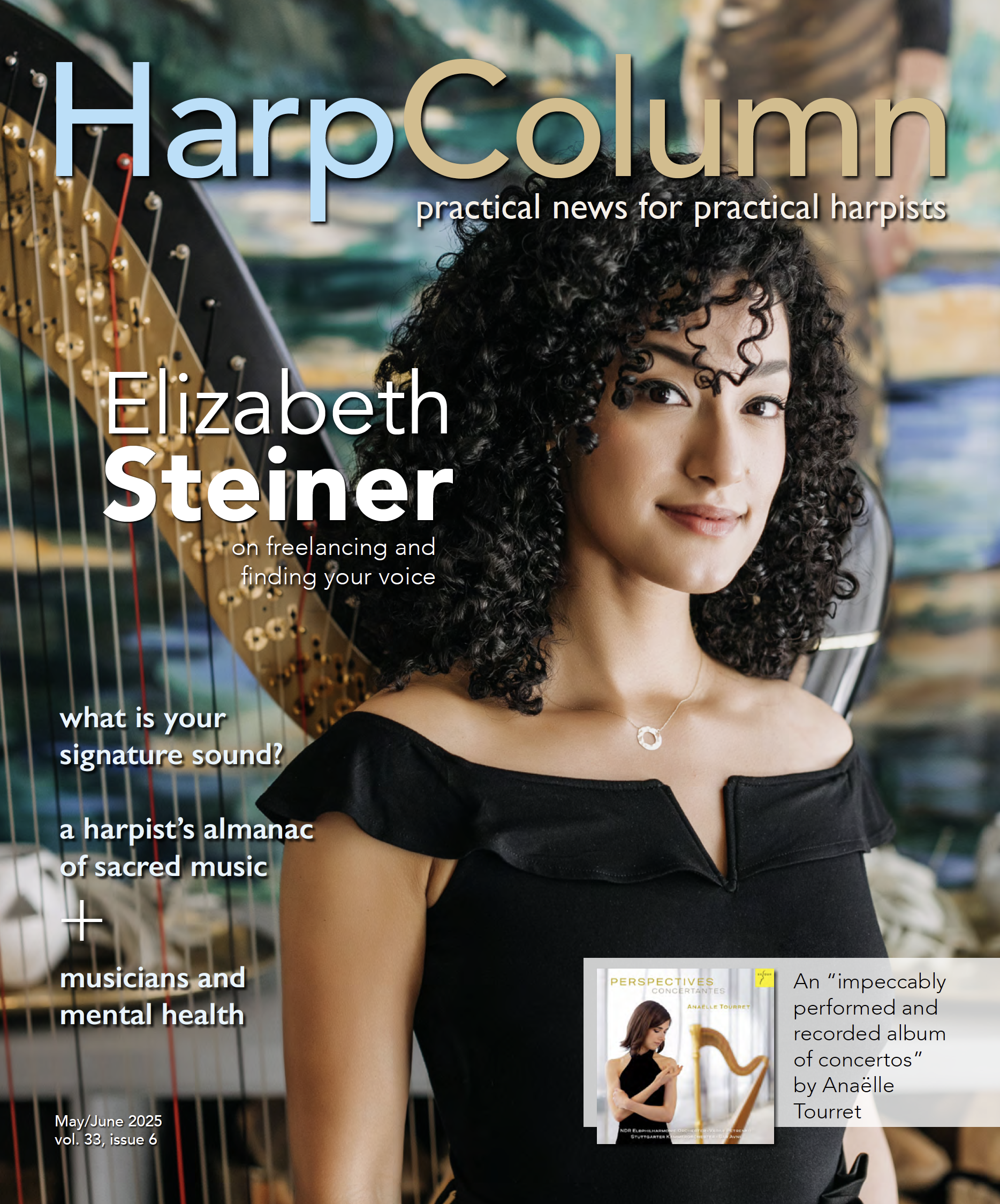Home › Forums › Teaching the Harp › rolling chords rhythmically
- This topic has 30 replies, 8 voices, and was last updated 18 years, 2 months ago by
unknown-user.
-
AuthorPosts
-
March 13, 2007 at 4:27 am #87970
Elizabeth Volpé Bligh
ParticipantSaul brought up an interesting point about rolled chords in another thread. Harpists often get so involved in the loveliness of their rolled chords that they forget to play rhythmically (or in tempo, but that’s my addition). Conductors usually ask for the last note of the rolled chord to be on the beat, so that the arpeggio is like an extended grace note. When we play solo, we have to remember that, even though there is nobody in front of us with fabulous hair and a tux swinging a stick, the pulse still exists and should be respected. We don’t want to sound like a metronome either, but there’s a happy medium. Thoughts? Flames? Jokes?
March 13, 2007 at 7:41 am #87971unknown-user
ParticipantWhoops,
March 13, 2007 at 1:04 pm #87972carl-swanson
ParticipantAs I think I mentioned in the other thread, you should have many ways of rolling a chord, and the way you roll the chord should then be appropriate to the musical context of the piece. You can roll a chord very very fast, starting on the beat, as in the opening chords of the Danses(read my article on that subject), or roll much slower and more lush, ending on the beat, as in the opening statement of the Faure Impromptu. In the final chord of the Serenade of Parish-Alvars, I start the roll slowly and do a quick accelerando to the top as well as making a crescendo over the roll. In the harp cadenza to Brittens Young Persons guide… the opening chords are usually rolled as you mentioned above, both 4th fingers together, both 3rd, etc.
I once attended a ‘cello masterclass given by Rostropovitch(I don’t play the ‘cello!) and he told one of the students that you should have many ways of making the vibrato. I think it’s the same thing with rolled chords.
March 13, 2007 at 2:23 pm #87973rosalind-beck
ParticipantElizabeth, you make an excellent point regarding the need for rolled chords to have rhythmic precision.
March 13, 2007 at 11:49 pm #87974unknown-user
ParticipantDoes anyone know the term for rolling both hands simulateously? Just curious, as I
March 14, 2007 at 5:14 am #87975erin-wood
ParticipantI call it a short roll as opposed to a long roll–but I don’t know if that is the correct terminology.
March 14, 2007 at 8:25 am #87976carl-swanson
ParticipantI don’t think I’ve ever heard a term applied to that.
March 14, 2007 at 8:57 am #87977unknown-user
ParticipantHi Erin,
Thanks for that info – even if it isn’t entirely the right terminology, what people commonly call it is a help. And thanks for the advice.
I think the french term may be Serrer, or Serres……can’t make out the handwriting …
And Erin, can I ask you a question about it?? When you use that technique, is the goal to bring out the top notes loudly, or do you normally play the bottom note on the beat. Or, is variety the spice of life (either okay).
I love hearing about techniques employed in other styles, and also what the goal is in execution.
I actually have it marked in Tchaikovsky, Swan Lake and Sleeping Beauty, for the rolled chords in those. I inherited those parts from an absolutely lovely harpist that played in an opera and ballet orchestra – and I find that her fingerings and terminolgies are so interesing.
I don’t actually use that effect myself, but I am intrigued as to what the goal was in these passages.
I was thinking that it may also be of use in Britten, where you have three note chords in each hand, rather than a wide spread. I imagine its good for
March 14, 2007 at 12:51 pm #87978carl-swanson
ParticipantThe French word ‘serrer’ means to squeeze, grip, or push. On highways in France for example you’ll see a sign that says ‘serrez a droit,’ meaning, move to the right. In music, serre is another term fo accelerando(basically, to squeeze the notes together). It has nothing to do with rolling chords.
March 14, 2007 at 8:55 pm #87979unknown-user
ParticipantThanks for the run down of what the word serres means, and I’d say that it definitely is a clue to how to execute those chords – accelerando and/or to squeeze and push together.
I disagree with you, as if it had nothing to do with rolling chords the harpist involved would not have written it in her part and mentioned that the term refered to a different technique. Maybe she just went to a different teacher than you did, or maybe it was a term of her own devising….I have no idea, but I thought that this was a good forum to sort that out.
March 14, 2007 at 9:12 pm #87980carl-swanson
ParticipantMaybe she was a French harpist whose teacher used the term. I studied in France with Pierre Jamet, and I don’t remember him ever using a term for a specific type of rolled chord.
March 14, 2007 at 11:52 pm #87981Tacye
ParticipantI was taught to roll the two hands simultaneously before I was taught to roll them sequentially, I also spent as much time right at the start learning to arpeggiate downwards as up.
March 15, 2007 at 1:59 am #87982Elizabeth Volpé Bligh
ParticipantAre the chords marked “serrer” in the Lilac Fairy part of Sleeping Beauty? These inversions are in a moderato 6/8, and they do have to be squeezed together. (By the way, the spelling would indeed be “serrer”, since there is no “serres” in French.) I imagine that translates to “cracked” or, in other words, very rapidly broken. I play the left hand straight and the right hand barely broken, just to get that “fairy” sound but keep the tempo clear. If it’s really fast, then I turn them into triad inversions instead of 4-note chords. I know it’s cheating, but once the tempo steps over that line, it’s every man for himself.
March 15, 2007 at 3:20 am #87983unknown-user
ParticipantThanks for that Elizabeth, good to hear that I’m not mad (well, not entirely anyway!).
Yes, the chords at the beginning of the Lilac Fairy section are marked Serrer.
And also in the second page of the Swan Lake Cadenza – the ascending rolled chords (triads
March 15, 2007 at 3:07 pm #87984rosalind-beck
ParticipantElizabeth, I am interested in this discussion of the chords in “Sleeping Beauty.”
-
AuthorPosts
- You must be logged in to reply to this topic.






